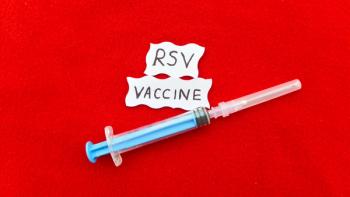Approximately 3% to 4% of patients with metastatic colorectal cancer have the KRAS G12C mutation. Currently, these patients have limited late-line standard therapy options. Common late-line regimens such as trifluridine/tipiracil (Lonsurf; Taiho Oncology) or regorafenib (Stivarga; Bayer) are associated with very limited efficacy. Sotorasib (Lumakras; Amgen) is a KRAS G12C inhibitor that inhibits downstream proliferation and survival. Although it has shown success in treating patients with non–small cell lung cancer with KRAS G12C mutations, it has not shown as much efficacy in colorectal cancer as a single agent. This is because treatment resistance occurs through the EGFR pathway. Findings from the recent phase 1b CodeBreak 101 trial (NCT04185883) showed a response rate of 30% when combining sotorasib and panitumumab (Vectibix Amgen), an EGFR inhibitor, in patients with chemotherapy-refractory colon cancer compared with a 10% response rate with sotorasib alone.
Investigators of the study aimed to analyze the effectiveness of sotorasib in combination with panitumumab as a treatment option for patients with chemotherapy-refractory metastatic colorectal cancer with the KRAS G12C mutation. The CodeBreak300 trial (NCT05198934) was a phase 3, multicenter, open-label, randomized, active-controlled study.
In the study, investigators included adults with metastatic colorectal cancer with the KRAS G12C mutation (confirmed by prospective central molecular testing) who had no previous treatment history with KRAS G12C inhibitors but had further progression of disease after already receiving a therapy. Previous therapies must have included fluoropyrimidine, oxaliplatin, and irinotecan. Trifluridine/tipiracil or regorafenib were permitted if inadmissible adverse effects were experienced with the other therapies. Patients were also required to have measurable disease according to RECIST version 1.1; an ECOG performance status of 0, 1, or 2; and adequate organ function. Investigators assigned treatment with sotorasib 960 mg or 240 mg orally once daily and an intravenous infusion of panitumumab 6 mg/kg administered every 2 weeks for 28 days.
The investigators compared sotorasib/panitumumab treatment with trifluridine/tipiracil with a starting dose of 35 mg/m2 orally once daily and a maximum dose of 80 mg or 75 mg for patients in Japan on days 1 through 5 and days 8 through 12 on a 28-day treatment cycle. Another treatment randomly assigned to patients was regorafenib 160 mg orally once daily on days 1 through 21 on a 28-day treatment cycle.
Investigators used PFS as the primary outcome, defined by the first occurrence of disease progression since random assignment according to RECIST version 1.1 or by death. Secondary end points included overall survival (OS), objective response (according to RECIST version 1.1), duration and time to response, disease control of a complete response plus partial response plus stable disease for at least 7 weeks per blinded independent central review, safety, pharmacokinetics, and quality of life. Furthermore, investigators assessed objective PFS and objective response.
Of the 219 patients assessed for eligibility, 160 patients underwent treatment randomization, with 53 patients receiving sotorasib 960 mg plus panitumumab, 53 patients receiving sotorasib 240 mg plus panitumumab, and 54 patients receiving standard of care. Three patients ended up not receiving standard of care and were thus not included in the safety analysis.
Baseline characteristics were similar across the treatment groups, with the exception of race. More White patients received sotorasib 960 mg plus panitumumab, and more Asian patients received sotorasib 240 mg plus panitumumab. Only 1 Black patient was enrolled in the study. The median age was 62 years (range, 34-82), and 49.4% of patients were men. Most patients (60%) had an ECOG status of 0.
The median range of treatment for the 960-mg sotorasib/panitumumab group, 240-mg sotorasib/panitumumab group, and standard treatment group was 5.8 months (range, 1.0-13.2), 4.1 months (range, 0.9-10.1), and 2.2 months (range, 0.8-10.3), respectively, and the overall median follow-up was 7.8 months (range, 0.1-13.9). A significantly longer median PFS was observed by blinded independent central review in both the 960- mg sotorasib/panitumumab (5.6 months; HR, 0.49; 95% CI, 0.3-0.8) and 240-mg sotorasib/ panitumumab (3.9 months; HR, 0.58; 95% CI, 0.36-0.93) treatment groups when compared with the standard treatment group (2.2 months). The objective response for the 2 treatment groups was 26.4% and 5.7%, respectively, compared with a 0% objective response in the standard care treatment group. Of note, 1 patient in the 960-mg sotorasib/panitumumab group had a complete response. Investigator-assessed responses showed similar results. Overall survival data were not yet mature at time of analysis.
About The Author
Grace Morrison is a second-year professional pharmacy student attending the University of Connecticut and is part of the UConn Pharmacy Leaders Track as well as a member of Lambda Kappa Sigma, Phi Lambda Sigma, and other professional organizations.
The most common treatment-related adverse effects (TRAEs) for both the 960-mg sotorasib/panitumumab and 240-mg sotorasib/panitumumab groups included hypomagnesemia (~ 30% for both groups), rash (28% and 25%, respectively), and dermatitis acneiform (23% and 38%, respectively). In the standard treatment group, common TRAEs included neutropenia (31%) and nausea (29%). Grade 3 or higher TRAEs included hypomagnesemia (7.5% [940 mg] and 5.7% [240 mg]), rash (5.7% [960 mg]), dermatitis acneiform (11.3% [960 mg]), diarrhea (5.7% [240 mg]), neutropenia (23% [standard group]), hypertension (5.9% [standard group]), and anemia (5.9% [standard group]). Hepatotoxicity occurred in 11.3%, 5.7%, and 7.8% in the 960-mg sotorasib/panitumumab group, 240-mg sotorasib/panitumumab group, and standard treatment group, respectively. No pharmacokinetic drug interactions with sotorasib and panitumumab were identified.
The combination treatment of sotorasib plus panitumumab significantly prolongs PFS in patients with metastatic colorectal cancer and the KRAS G12C mutation and is associated with no additional or unexpected adverse effects. Longer follow-up data from this study are needed to analyze long-term outcomes such as OS. Additionally, although it was an international study spanning 12 countries, most trial participants were White or Asian patients, with only 1 Black patient. This medication combination proved to be a more efficacious therapy for patients with metastatic colorectal cancer with the KRAS G12C mutation compared with monotherapy or standard treatments, with a longer PFS and a higher incidence of response.
Reference
Fakih MG, Salvatore L, Esaki T, et al. Sotorasib plus panitumumab in refractory colorectal cancer with mutated KRAS G12C. N Engl J Med. 2023;389(23):2125-2139. doi:10.1056/NEJMoa2308795





















































































































































































































